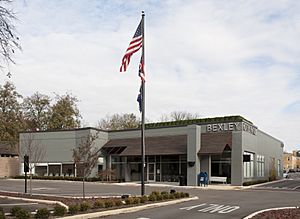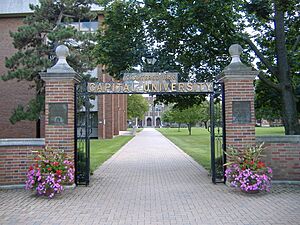Bexley, Ohio facts for kids
Quick facts for kids
Bexley, Ohio
|
|||
|---|---|---|---|

Bexley City Hall
|
|||
|
|||
| Country | United States | ||
| State | Ohio | ||
| County | Franklin | ||
| Government | |||
| • Type | Mayor–Council | ||
| Area | |||
| • Total | 2.44 sq mi (6.32 km2) | ||
| • Land | 2.42 sq mi (6.27 km2) | ||
| • Water | 0.02 sq mi (0.05 km2) | ||
| Elevation | 791 ft (241 m) | ||
| Population
(2020)
|
|||
| • Total | 13,928 | ||
| • Estimate
(2023)
|
12,785 |
||
| • Density | 5,708/sq mi (2,203.8/km2) | ||
| Time zone | UTC-5 (EST) | ||
| • Summer (DST) | UTC-4 (EDT) | ||
| ZIP code |
43209
|
||
| Area code | 614 and 380 | ||
| FIPS code | 39-06278 | ||
| GNIS ID | 1086097 | ||
Bexley is a city in Franklin County, Ohio, United States. In 2020, about 13,928 people lived there. The city is a suburban area right next to Columbus. It sits along the banks of Alum Creek, east of Columbus.
Bexley was founded in 1908. It was created when two communities, Bullitt Park and Pleasant Ridge, joined together. They met at the National Road (Main Street), which goes right through the city.
Capital University and Trinity Lutheran Seminary are both located in Bexley. The city also has large, beautiful homes. These include the Ohio Governor's Mansion and the Jeffrey Park Mansion, also known as "Kelveden." This mansion is the home of the president of Ohio State University.
Contents
History of Bexley
Bexley got its name from an early resident, Colonel Lincoln Kilbourne. He suggested the name to honor his family's origins in Bexley, a place in London, England.
The village of Bexley was officially formed in 1908. This happened when important citizens from Bullitt Park, located north along Alum Creek, agreed to merge with the Pleasant Ridge community to the south. Bullitt Park included people like Robert H. Jeffrey, who was a successful businessman and a former mayor of Columbus.
Pleasant Ridge was near Capital University, which started in 1850, and the Evangelical Lutheran Theological Seminary, founded in 1830. Both of these schools are now connected with the Evangelical Lutheran Church in America.
How Bullitt Park Started
Bullitt Park began in 1889. Logan M. Bullitt from Philadelphia first planned out the area. Wealthy people from Columbus started building large homes to the east along Broad Street. By the 1890s, several big houses were built in the Bullitt Park area. One of these became the first campus for the Columbus School for Girls, which is still a private school in Bexley today.
Impact of the Spanish-American War
The Spanish–American War also played a part in Bexley's early development. In 1898, Ohio Governor Asa Bushnell chose an area in Bullitt Park as a meeting spot for state volunteers. This place, called Camp Bushnell, hosted 8,000 Ohio recruits for three weeks before they headed to Cuba.
This camp led to the installation of water and sewer lines for the soldiers. This important infrastructure helped prepare the area for more building and growth in the years that followed.
Becoming a City
By 1908, the residents of Bullitt Park and Pleasant Ridge decided to combine their neighborhoods. They officially became the Village of Bexley. The village grew, and by 1928, it reached the 5,000 people needed to become a city in Ohio. On January 1, 1932, Bexley officially became a city.
William A. Schneider was elected as the first mayor in 1935. He oversaw the building of the first city hall. Mayor Schneider led Bexley through a long period of growth and stayed in office for 32 years before he retired.
Bexley as an Arboretum
In March 2013, the city of Bexley received a special recognition. It was accredited as an arboretum by the Morton Register of Arboreta. This made Bexley the first city in the United States to get this special title. An arboretum is a place where many different kinds of trees are grown for study and display.
Geography of Bexley
Bexley covers a total area of about 2.45 square miles. Most of this area, about 2.43 square miles, is land. A very small part, about 0.02 square miles, is water.
People and Community
In 2020, Bexley had a population of 13,928 people. The city is sometimes thought of in three parts: North Bexley, Central Bexley, and South Bexley.
North Bexley, especially the Bullitt Park area, has many large, mansion-like homes. Central Bexley mostly has large homes, and many residents are professionals. South Bexley has smaller homes, and many residents are younger professionals or people working in trades.
Bexley is a diverse community with residents from various backgrounds. It is home to many different religious groups. There are several churches, including Lutheran, United Methodist, and Episcopal churches. Bexley also has many Jewish residents and is home to three synagogues: Agudas Achim, Ahavas Sholom, and Torat Emet. There are also Roman Catholic churches just outside Bexley's borders. The community is becoming more diverse, with more African-American and mixed-race families moving in.
Arts and Culture in Bexley
Bexley has many churches and synagogues. It also has several historic sites and outdoor sculptures. Part of U.S. Route 40, known as the National Road, runs through Bexley. Next to Bexley, to the west, is the Franklin Park Conservatory, a beautiful botanical garden.
Jeffrey Mansion
The Jeffrey Mansion was built between 1903 and 1905. It was built by Robert H. Jeffrey, whose father founded the Jeffrey Manufacturing Company. The mansion sits on nearly 40 acres of land in North Bexley. This land includes two parks.
The mansion is open to the public and offers cultural and arts education programs. The land behind the mansion is also open to everyone. It has stone staircases that lead to walking trails along Alum Creek. There are also tennis courts and the Bexley community swimming pool.
Public Art
Bexley is home to several sculptures created by the artist Alfred Tibor. You can find his works at the Trinity Lutheran Seminary, Saint Charles Preparatory School, and the Congregation Agudas Achim.
Education in Bexley
Bexley's public schools are managed by Bexley City Schools. This system includes Bexley High School, Bexley Middle School, and three elementary schools.
The city also has two private schools. These are Columbus School for Girls, which is the only all-girls high school in Franklin County, and Saint Charles Preparatory School, an all-boys Catholic school. Another all-boys private school, Columbus Academy, was originally in Bexley but moved to Gahanna in 1968.
Two colleges are located in Bexley: Capital University and Trinity Lutheran Seminary. Capital University is a private university that focuses on liberal arts. Trinity Lutheran Seminary is part of Capital University. Both schools were founded in 1830 and are connected with the Evangelical Lutheran Church in America (ELCA).
Notable People from Bexley
Many interesting people have lived in Bexley, including:
- Marco Arment, a main developer for the blogging website Tumblr.
- Ross Friedman, a professional soccer player.
- Bob Greene, a former newspaper columnist who wrote the book Be True to Your School.
- Michael Jeffries, the former chief executive officer of Abercrombie & Fitch.
- Frank Lesser, a writer for the TV show The Colbert Report.
- Josh Radnor, the star of the CBS sitcom How I Met Your Mother.
- Laurie Lea Schaefer, who was Miss America in 1972.
- Maggie Smith, a poet and author.
- R. L. Stine, a famous children's author.
- Harvey Wasserman, a writer and activist.
- David Wilhelm, who managed Bill Clinton's 1992 presidential campaign and was a senior advisor for Joe Biden's 2008 presidential campaign.
See also
 In Spanish: Bexley (Ohio) para niños
In Spanish: Bexley (Ohio) para niños





